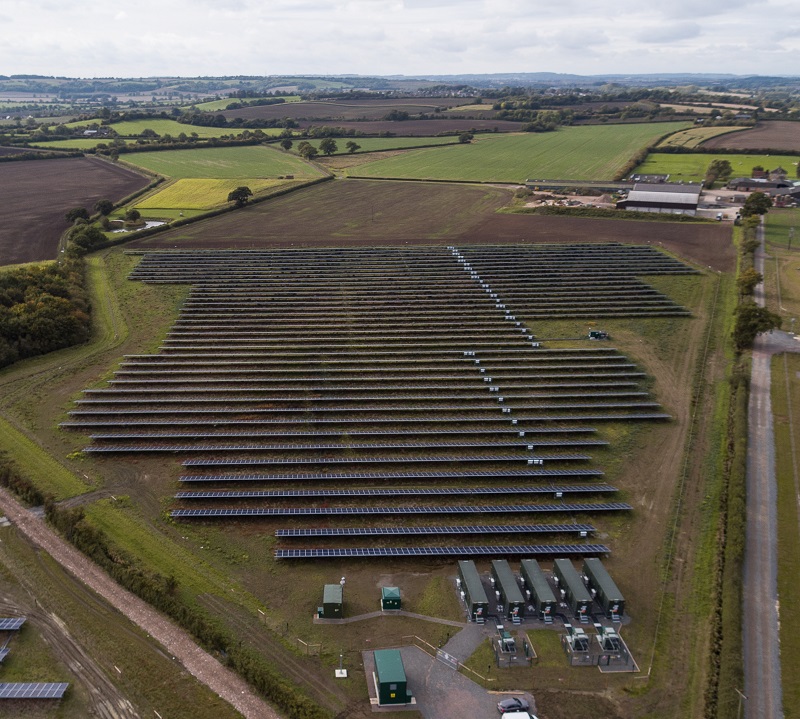British renewable energy developer Anesco has this week ushered in a new, potentially transformative era in U.K. solar energy with the official unveiling of the country’s first subsidy-free solar farm.
Located near Flitwick in the southern English county of Bedfordshire, the 10 MW Clayhill solar farm is the first ground-mounted installation in the country to operate without any form of government support, and could pave the way for a solar revolution 2.0 fuelled by lower-cost solar and balance of systems (BOS) components and supported by integrated energy storage.
The Clayhill solar farm has a 6 MW battery storage unit collocated onsite – an additional feature that will ensure the installation becomes an immediately valuable addition to the National Grid.
Claire Perry, MP BEIS minister for Climate Change & Industry, waxed lyrical about the commissioning of such an installation – particularly at a time when it is increasingly clear that no further solar subsidy is likely to be forthcoming from the British government.
“The cost of solar panels and batteries has fallen dramatically over the past few years, and this first subsidy-free development at Clayhill is a significant moment for clean energy in the U.K.,” Perry said.
“Solar panels already provide enough electricity to power 2.7 million homes with 99% of that capacity installed since 2010. The government is determined to build on this success and our ambitious Clean Growth Strategy will ensure we continue to lead the world on the transition to a low carbon economy,” she added.
Anesco’s executive chairman Steve Shine remarked at the plant’s opening that the Clayhill installation proves that the government’s decision to withdraw subsidies for PV does not have to signal the end of solar as a commercially viable technology in the U.K.
“Given our extensive experience with solar and storage projects, we took a fresh look at how we could finance and develop Clayhill without needing a renewables subsidy,” Shine revealed. “We sought the views of our supply chain and with them looked at every aspect of the project – its design, the technical specifications, the use of the very latest technology and the costs of the various components. By deciding to co-locate the 6 MW battery storage unit and by working closely with our supply chain partners, we have been able to achieve a subsidy-free development.”
Popular content
The installation was completed in just 12 weeks, and augments Anesco’s growing PV portfolio, which now comprises more than 100 solar farms across the country. The company also has a handful of further subsidy-free solar installations in the pipeline.
The Clayhill installation uses BYD solar panels and five of its battery storage units. China’s Huawei supplied its 1,500 v string inverters for the project – the first time that Huawei has installed this technology in Europe. Lord Browne of Madingley, Chair of Huawei UK, added: “This project is evidence of how solar is not only one of the most competitive renewables, but is now able to compete with all forms of generation. Huawei is pleased to have played a role in delivering Clayhill Solar Park.”
Despite solar’s stunning, subsidy-driven growth between 2014-16 – boosting cumulative installed capacity to more than 12 GW – PV was shunned from the latest Contracts for Difference (CfD) auction, which saw offshore wind sweep up the bulk of the subsidies for renewable energy.
Despite the undoubted positive impact that subsidy-free solar can have on the U.K. clean energy landscape, the nation’s leading solar organization the Solar Trade Association (STA) was lukewarm on the notion that the Anesco project could act as a beachhead for further low-cost solar.
“We absolutely applaud Anesco but government shouldn’t then assume the industry is away – it isn’t,” an STA spokesperson told the FT. “It is only going to be exceptional projects that are built subsidy free. What we are asking for is a level playing field for solar power.”
Anesco’s Shine admitted that the Clayhill farm would not pay with solar by itself at the moment – the storage support is key to ensuring its viability because by providing grid balancing services to the National Grid it can receive the extra payments offered to electricity generators that help to ensure high voltage transmission systems remain stable and absorb excess power when solar and wind load the grid.
This content is protected by copyright and may not be reused. If you want to cooperate with us and would like to reuse some of our content, please contact: editors@pv-magazine.com.


6 comments
By submitting this form you agree to pv magazine using your data for the purposes of publishing your comment.
Your personal data will only be disclosed or otherwise transmitted to third parties for the purposes of spam filtering or if this is necessary for technical maintenance of the website. Any other transfer to third parties will not take place unless this is justified on the basis of applicable data protection regulations or if pv magazine is legally obliged to do so.
You may revoke this consent at any time with effect for the future, in which case your personal data will be deleted immediately. Otherwise, your data will be deleted if pv magazine has processed your request or the purpose of data storage is fulfilled.
Further information on data privacy can be found in our Data Protection Policy.